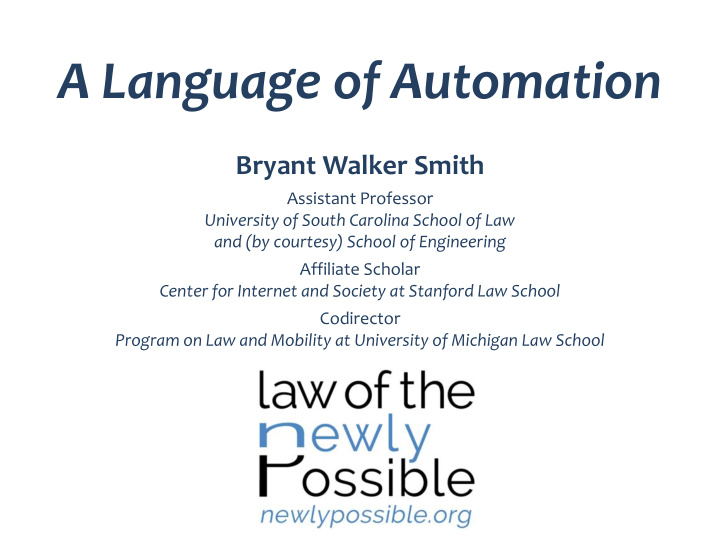



A Language of Automation Bryant Walker Smith Assistant Professor University of South Carolina School of Law and (by courtesy) School of Engineering Affiliate Scholar Center for Internet and Society at Stanford Law School Codirector Program on Law and Mobility at University of Michigan Law School
Upshot • Say what you mean • Definitions should help, not hinder • Emerging international consensus • Key distinctions • Companies drive automated vehicles
Say what you mean “driver” “control” “driverless” “self - driving” “autonomous” “fully automated” “highly automated”
“Drivers shall at all times be able to control their vehicles” 1949 Vienna Convention on Road Traffic; cf. 1968 Geneva Convention on Road Traffic
https://commons.wikimedia.org/wiki/File:Feedback_loop_with_descriptions.svg
https://www.flickr.com/photos/dumbledad/3225255407
https://www.flickr.com/photos/31029865@N06/14997552775
Definitions should help, not hinder • Definitions are a means, not an end • Do use definitions to speak clearly and efficiently • Do not let definitions slow substantive progress • “Don’t let the perfect be the enemy of the good” • When in doubt, just say what you mean !
Emerging international consensus • BASt definitions (2013) • SAE J3016 (2014, 2016, 2018 ) – “Taxonomy and Definitions for Terms Related to On - Road Motor Vehicle Automated Driving Systems” • Declaration of Amsterdam (EU members + EC) • ISO/SAE 22736 joint working group • Global Forum for Road Traffic Safety Resolution on Highly and Fully Automated Vehicles • National practice….
Key distinctions • Trips • Vehicles • Features
Driving • Driving involves paying attention to the vehicle, the road, and the environment so that you can steer, brake, and accelerate as needed. • If you’re expected to pay attention, you're still driving — even when a vehicle feature is assisting you with steering, braking, and/or accelerating. • Driving may have an even broader legal meaning ( including in UNECE conventions ).
Types of trips • You must drive for the entire trip • You will need to drive if prompted in order to maintain safety • You will need to drive if prompted in order to reach your destination • You will not need to drive for any reason, but you can drive if you want • You will not need to drive for any reason, and you can’t drive
Types of vehicles • Vehicles you can drive • Vehicles you can’t drive
Types of vehicle features • The levels of driving automation describe features in vehicles rather than the vehicles themselves. This is because a vehicle’s feature or features may not always be engaged or even available. • The operational design domain (ODD) describes when and where a feature is specifically designed to function. For example, one feature may be designed for freeway traffic jams, while another may be designed for a particular neighborhood in good weather.
Assisted driving features • L0 : You’re driving • L1 : You’re driving, but you're assisted with either steering or speed • L2 : You’re driving, but you're assisted with both steering and speed
Automated driving features • L3 : You’re not driving, but you will need to drive if prompted in order to maintain safety • L4 : You’re not driving, but either – a) you will need to drive if prompted in order to reach your destination (in a vehicle you can drive) or – b) you will not be able to reach every destination (in a vehicle you can’t drive) • L5 : You’re not driving, and you can reach any destination
But this gets complicated fast On reaching a crash site, an ADS-equipped vehicle stops in its lane until someone at a monitoring center sketches a travel path. Using its sensors, it then follows this path. 1) What level is this feature? 2) Is there a remote driver?
Promise to the public By describing a feature’s level of automation and operational design domain, the feature’s developer makes a promise to the public about that feature’s capabilities
Companies drive automated vehicles • Is an individual user driving the vehicle? OR • Is a company driving the vehicle ?
Recommend
More recommend